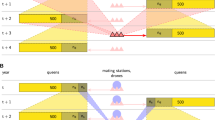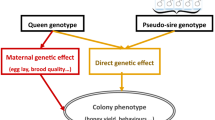Summary
Although honeybee workers are usually infertile, in queenless colonies some workers can develop ovaries and produce offspring. Therefore the classical Darwinian fitness of workers is not zero. Experimental studies in the Cape honey bee (Apis mellifera capensis) reveal a huge genetic variation for individual fitness of workers. The present study with a one locus, two allele model for reproductive dominance of workers shows that a balanced system between colony level and individual within colony selection plausibly explains the phenomenon of a high genetic variance of worker fitness. In particular, a frequent occurrence of queenless colonies in the population leads to stable polymorphic equilibria. Also the multiple mating system of the honey bee queen supports the propagation of alleles causing reproductive dominance of workers.
Similar content being viewed by others
References
Adams J, Rothman ED, Kerr WE, Paulino ZL (1977) Estimation of the number of sex alleles and queen matings from diploid male frequencies in a population of Apis mellifera. Genetics 86:583–596
Boorman SA, Levitt PR (1980) The Genetic of Altruism. Academic Press, New York, NY
Bulmer M (1980) The Mathemetical Theory of Quantitative Genetics. Clarendon Press, Oxford, UK
Cavalli-Sforza LL, Feldman MW (1978) Darwinian selection and “altruism”. Theor Pop Biol 14:268–280
Craig R (1979) Parental manipulation, kin selection and the evolution of altruism. Evolution 33:319–334
Craig R (1983) Familial selection and the evolution of social behaviour re-examined. J Theor Biol 103:287–294
Crewe RM (1982) Compositional variability: the key to the social signals produced by honeybee mandibular glands. In: Breed MD, Michener CD, Evans HE (eds) The Biology of Social Insects. Westview Press, Boulder, CO, pp 318–322
Crewe RM, Velthuis HHW (1980) False queens: a consequence of mandibular gland signals in worker honeybees. Naturwissenschaften 67:467
Darwin C (1859) The Origin of Species. Murray, London, UK
Ewing E (1979) Genetic variation in heterogenous environment VII. Temporal and spatial heterogeneity in infinite populations. Am Nat 114:197–212
Falconer DS (1981) Introduction to Quantitative Genetics. 2nd Edition, Longman, New York, NY
Falconer DS (1989) Introduction to Quantitative Genetics, 3rd Edition, Longman, New York, NY
Felsenstein J (1976) The theoretical population genetics of variable selection and migration. Ann Rev Genet 10:253–280
Fisher RA (1930) The Genetical Theory of Natural Selection. Clarendon Press, Oxford, UK
Haldane JBS (1932) The Causes of Evolution. Longmans, Green and Co., London, UK
Hamilton WD (1964a) The genetical evolution of social behavior. I. J Theor Biol 7:1–16
Hamilton WD (1964b) The genetical evolution of social behavior II. J Theor Biol 7:17–52
Hemmling C, Koeniger N, Ruttner F, (1979) Quantitative Bestimmung der 9-Oxodecensäure im Lebenszyklus der Kapbiene (Apis mellifera capensis Escholtz). Apidologie 10:227–240
Hillesheim E (1987) Does worker dominance reduce group fitness of honeybees (Apis mellifera capensis Escholtz)? In: Eder J, Rembold H (eds) Chemistry and Biology of Social Insects, Peperny, Munich, FRG, pp 360–361
Hillesheim E, Koeniger N, Moritz RFA (1989) Colony performance in honeybees (Apis mellifera capensis Esch.) depends on the ratio of subordinate and dominant workers. Behav Ecol Sociobiol 24:291–296
Laidlaw HH, Page RE (1984) Polyandry in honeybees (Apis mellifera capensis L.): sperm utilization and intracolony relationship. Genetics 108:985–997
Lande R (1976) The maintenance of genetic variability by mutation in a polygenic character with linked loci. Genet Res 26:221–234
Levitt PR (1975) General kin selection models for genetic evolution of sib altruism in diploid and haplodiploid species. Proc Natl Acad Sci USA 72:4531–4535
Lin N, Michener CD (1972) Evolution of sociality in insects. Q Rev Biol 47:35–57
Michod RE (1982) The theory of kin selection. Annu Rev Ecol Syst 13:23–55
Moritz RFA (1986a) Intracolonial worker relationship and sperm competition in the honeybee (Apis mellifera L.). Experientia 42:445–448
Moritz RFA (1986b) Two parthenogenetical strategies of laying workers in populations of the honeybee, Apis mellifera (Hymenoptera: Apidae). Entomol Gener 11:159–164
Moritz RFA, Hillesheim E (1985) Inheritance of dominance in honeybees (Apis mellifera capensis Esch.). Behav Ecol Sociobiol 17:87–89
Moritz RFA, Kauhausen D (1984) Hybridization between Apis mellifera capensis and adjacent races of Apis mellifera. Apidologie 15:211–222
Mousseau TA, Roff DA (1987) Natural selection and the heritability of fitness components. Heredity 59:181–197
Noordwijk AJ van (1984a) Quantitative genetics in natural populations of birds illustrated with examples from the great tit, Parus major. In: Wöhrmann K, Löschke V (eds) Population Biology and Evolution, Springer Verlag, Heidelberg, FRG, pp 67–79
Noordwijk AJ van (1984b) Problems in the analysis of dispersal and a critique on its ‘heritability’ in the Great tit. J Anim Ecol 53:533–544
Noordwijk AJ van, Balen JH van, Scharloo W (1980) Heritability of ecological important traits in the great tit. Ardea 68:193–203
Noordwijk AJ van, Balen JH van, Scharloo W (1981) Genetic and environmental variation in clutch size of the great tit (Parus major). Neth J Zool 31:342–372
Oster ARG, Wilson EO (1978) Caste and Ecology in the Social Insects. Princeton Univ. Press, Princeton, New Jersey
Owen RE (1986) Colony-level selection in the social insects: Single locus additive and nonadditive models. Theor Popul Biol 29:198–234
Page RE, Erickson EH (1988) Reproduction by worker honey bees (Apis mellifera L.). Behav Ecol Sociobiol 23:117–126
Ruttner F (1988) Biogeography and Taxonomy of Honeybees. Springer, Berlin, FRG
Ruttner F, Hesse B (1981) Rassenspezifische Unterschiede in der Ovarentwicklung und Eiablage von weisellosen Arbeiterinnen. Apidologie 12:159–183
Tiesler FK (1972) Die Inselbelegstellen aus dem Norden der BRD. In: Ruttner H, Harnaj V (eds) Paarungskontrolle und Selcktion bei der Honigbiene. Apimondia Publishing House, Bucharest, Rumania, pp 52–56
Tribe J (1983) What is the Cape bee? S Afr Bee J 55:77–87
Turelli M (1984) heritable genetic variation via mutation selection balance: Lerch's zera meets the abdominal bristle. Theor Popul Theory 25:138–193
Uyenoyama M, Feldman MW (1980) Theories of kin and group selection: A population genetics perspective. Theor Popul 17:380–414
Verma S, Ruttner F (1980) Cytological analysis of the thelytokous parthenogenesis in the cape honeybee (Apis mellifera capensis Esch.). Apidologie 14:41–57
Visscher PK (1986) Kinship discrimination in queen rearing by honey bees (Apis mellifera). Behav Ecol Sociobiol 18:453–460
Wade MJ (1979) The evolution of social interactions by family selection. Am Nat 113:399–417
Wilson DS (1975) A theory of group selection. Proc Natl Acad Sci USA 72:143–146
Wilson EO (1971) The Insect Societies. Harvard University Press, Cambridge, Massachusetts
Woyke J (1975) Natural and instrumental insemination of Apis cerana indica in India. J Apic Res 14:153–159
Author information
Authors and Affiliations
Rights and permissions
About this article
Cite this article
Moritz, R.F.A. Colony level and within colony level selection in honeybees. Behav Ecol Sociobiol 25, 437–444 (1989). https://doi.org/10.1007/BF00300190
Received:
Accepted:
Issue Date:
DOI: https://doi.org/10.1007/BF00300190




